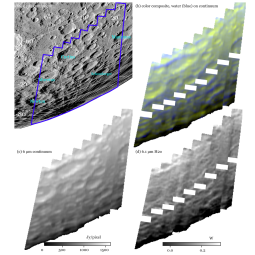By Bill Reach and Joan Schmelz
For the first time, SOFIA has made a detailed map of water on the surface of the Moon. Comparison with the lunar landscape shows that the water emission is strongest on the shady sides of deep craters and high mountains. Researchers used observations taken on 2022 February 17 as part of a SOFIA Legacy project intended to explore how water is distributed across the lunar surface.
Interest in lunar water was sparked by discoveries made in the last decade. Evidence for ice close to the South Pole was found by the NASA LCROSS mission, which dropped a rocket booster into a permanent shadow and observed water in the material raised from the surface by the impact. Evidence for widespread hydration came from observations of a 3 micron reflectance feature by the Indian Space Research Organization Chandrayaan-1 mission, which could be explained by hydroxyl (OH) and/or water (H 2 O). The 3 micron feature was also imaged by the NASA Deep Impact spacecraft and the ground-based Infrared Telescope Facility (IRTF) in Hawaii.
The 6 micron emissivity feature observed by SOFIA can only be produced by water, so there is no possible confusion with or contamination from hydroxyl. Early results from a pilot study showed that water is widespread, even on the sunlit surface of the Moon where isolated water molecules cannot survive for long without being outgassed. NASA’s LADEE mission measured a lack of water in the lunar atmosphere near the equator, indicating the surface is not outgassing. So the SOFIA result suggested that water molecules might be trapped inside materials such as volcanic glass. This way, the molecules can survive the harsh lunar days where temperatures can reach 250 degrees Fahrenheit.
The follow-up Legacy survey mapped a 90,000 square mile area near the South Pole with a resolution of about 3 miles. The observations were taken near the full Moon with sunlight coming from the north. The strength of the lunar water feature changes across the landscape in a way that was not anticipated, but can be explained qualitatively. For a mountain standing high above the surface, the north face will catch significantly more sunlight than the south side. So the colder side of the lunar mountains and the inner (northern) rims of lunar craters that face away from the Sun are found to have more water. The most prominent feature was a “wet ridge” near the top of the mapped region, with other arc-shaped features throughout the image.
If water were mobile across the surface (such as when it migrates from hotter locations that are outgassing), then it might stay longer in colder places and accumulate, even if only temporarily during the trek toward the permanent ice near the poles. If the water is not mobile, but is embedded in lunar materials, then the new results show that water becomes more observable at locations where the terrain is colder. This second hypothesis is of great importance, because it would suggest a much larger amount of water pervades the surface, rather than a light and transient frost.
